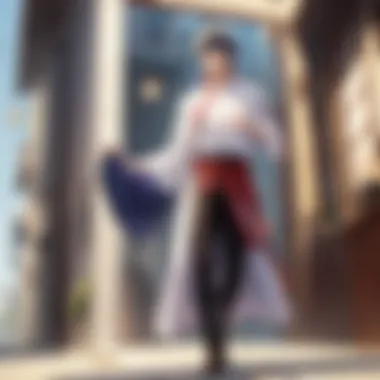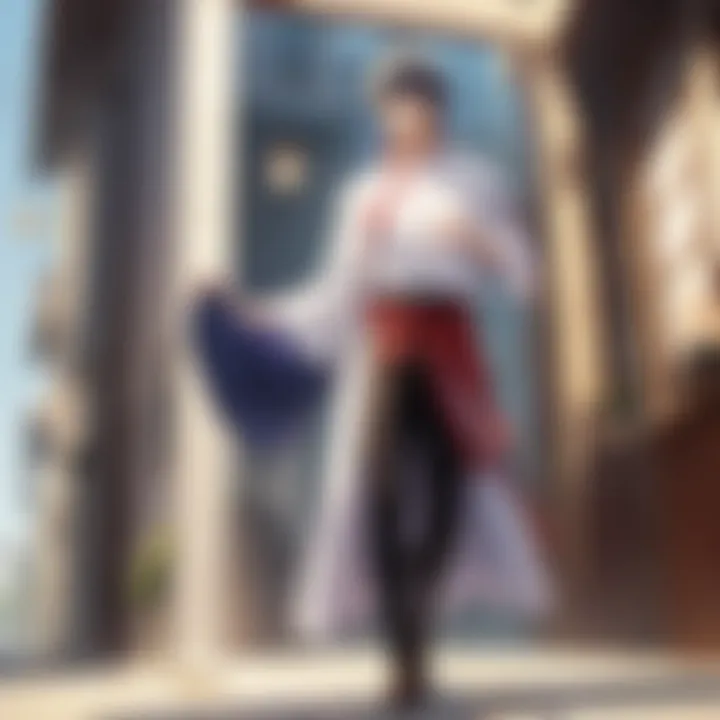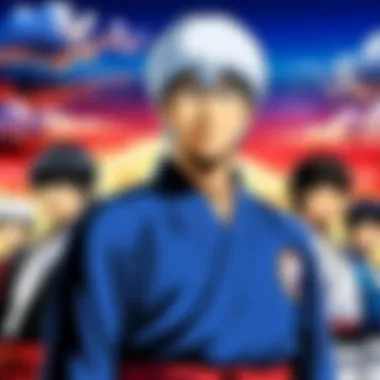An Analytical Review of Gintama Season 1


Intro
Gintama is more than just an anime series. It represents a unique blend of humor, action, and cultural commentary. The first season of Gintama captivates audiences not only with its engaging plot but also with the depth of its characters and themes. By delving into this series, one can see how it stands out in the anime landscape and why it has garnered such a dedicated following.
Character Profiles
Overview of Main Characters
The backbone of Gintama lies in its characters, each of whom adds a distinctive flavor to the narrative. Gintoki Sakata, the protagonist, is a samurai who embodies the show’s blend of absurdity and depth. His carefree demeanor conceals a strong moral compass and a deep sense of loyalty. This character's growth is central to the overall narrative, showcasing the struggles of independence and identity in a changing world.
Another key character is Shinpachi Shimura, who serves as a foil to Gintoki, often grounding the ridiculousness with his sense of duty and work ethic. Shinpachi’s development over the season highlights themes of friendship and camaraderie within challenging circumstances.
Lastly, Kagura, the third member of the main trio, is a force of nature. She may appear as a mere comic relief, but her character arc reveals layers of strength and vulnerability, representing the idea of family and connection in unconventional settings.
Supporting Characters
Supporting characters in Gintama also enrich the storyline. They include a colorful array of individuals, each contributing to various episodes and arcs. Characters like Toshiro Hijikata, the vice-commander of the Shinsengumi, bring a blend of seriousness with unexpected humor. Others, like Kondo Isao, add situational comedy that plays off the interactions with main characters.
Theme Exploration
Central Themes
Central to Gintama’s narrative is the exploration of freedom and individuality. The series effectively contrasts the traditional samurai code with modern desires, setting up a platform for humor and reflection. The show frequently addresses social issues, including the challenges of adhering to societal expectations while pursuing personal freedom.
The interplay of lightheartedness and serious topics is meticulously balanced, allowing viewers to engage with critical themes without losing entertainment value. The show's various arcs often highlight the consequences of actions, making viewers consider morality and justice.
Cultural References
Gintama is rich with cultural references that provide depth to its humor and storytelling. The series frequently parodies renowned historical events and figures from Japanese history, merging factual elements with exaggerated comedic interpretations. This approach not only entertains but also encourages viewers to explore and understand these cultural contexts.
"Cultural references in Gintama not only enhance its humor but also educate the audience, allowing for a richer viewing experience."
Popular Series and Recommendations
Top Anime Series of the Year
In the context of Gintama's premiere, several other notable anime series also captured viewers' attention. Shows like Naruto and Bleach offered action-packed narratives that complemented Gintama's unique humor and storytelling style.
Hidden Gems in Manga
For manga enthusiasts who appreciate the humor and clever narrative of Gintama, titles such as One Piece and KonoSuba: God's Blessing on This Wonderful World! should not be missed. These series, like Gintama, skillfully weave humor with compelling storytelling, appealing to lovers of insightful content.
In summary, Gintama Season 1 serves as a launching point for a spectacular journey through a vivid world of characters and narratives. It’s a series worth analyzing for anyone interested in the deeper layers of storytelling in anime.
Prelims to Gintama
The introduction to Gintama is crucial for understanding its unique place in the anime landscape. It sets the stage for both new viewers and seasoned fans. Analyzing the introduction allows us to appreciate not only the narrative structure but also the thematic elements that run through the series. What makes it unique is how it blends humor with serious undertones. These elements forge deep connections with the audience, encouraging both laughter and introspection. In this section, we will explore the series' background, alongside an overview of its first season, giving context to its impact.
Background of the Series
Gintama, created by Hideaki Sorachi, began serialization in Weekly Shōnen Jump in 2004. The series quickly gained recognition for its unorthodox humor and dynamic storytelling. The setting is a fictionalized version of Edo, where samurai live alongside alien invaders. This unusual premise opens vast opportunities for narrative creativity. Fans and critics alike applaud its ability to subvert traditional shōnen tropes. From the outset, Gintama challenges viewers with its layered storytelling. The series incorporates a wide variety of references, capturing the essence of Japanese culture, pop culture, and even history.
The blend of comedic elements with deeper societal critiques is a hallmark of the Gintama series. It conveys messages about friendship, responsibility, and the complexities of human nature, using comedy as a vehicle to address serious issues. With strong character development and engaging plotlines, Gintama distinguishes itself from other anime of its time. This complexity forms a loyal viewer base and contributes significantly to its cultural impact.


Overview of the First Season
The first season of Gintama comprises 201 episodes, beginning its journey in April 2006. Episodes vary from light-hearted comedic skits to serious story arcs. It introduces viewers to key players like Gintoki Sakata, Shinpachi Shimura, and Kagura. Each character serves a vital role, establishing a dynamic interplay that enhances the narrative's depth.
With episodic formats, the first season oscillates between standalone stories and overarching plots. While some episodes focus on comedy, others dive into emotional and moral dilemmas, presenting a rich tapestry of storytelling.
The overall pacing of the first season is brisk; it keeps viewers engaged without sacrificing character development. The balance between humor and depth creates an inviting atmosphere, allowing audiences to feel at home with the characters. Exploring this season is essential for comprehending the series' enduring appeal and cultural significance. It encapsulates the essence of Gintama, laying a strong foundation for future seasons.
Narrative Structure
The narrative structure of Gintama Season 1 is a key element in understanding the series' overall impact. It combines various storytelling techniques that engage viewers while also delivering profound themes. The way episodes are formatted plays a critical role in pacing and character development. By observing the narrative flow, one can appreciate how it sets the tone for humor and essential themes alike.
The series employs a non-linear storytelling style, allowing for episodic adventures mixed with longer character arcs. This dual approach enriches the viewing experience, as audiences are introduced to both stand-alone episodes and recurring themes. The format supports a dynamic approach to storytelling, promoting engagement by frequently shifting tones.
Another important factor is the character relationships that blossom throughout the season. Characters evolve not only through their individual episodes but also through interactions with others. This multifaceted character development enables viewers to see them in various lights, revealing depth and complexity.
Moreover, understanding the narrative structure aids in grasping the narrative's pacing, which oscillates between comedy, action, and poignant moments. The writing strikes a balance, maintaining emotional resonance while ensuring that humor does not undermine the story's seriousness.
In summary, the narrative structure of Gintama Season 1 paves the way for sophisticated storytelling techniques that influence character development and thematic exploration.
Episode Formatting
Episode formatting in Gintama is unconventional, one of its distinctive traits. Each episode typically runs about 24 minutes, encompassing a mix of comedy, action, and drama. The format allows for flexibility in content, providing space for both long story arcs and quick, humorous sketches. This fluidity makes Gintama feel fresh, as viewers can expect the unexpected.
Having both episodic tales and overarching narratives helps in footing the climaxes and resolutions effectively. Viewers are not left feeling overwhelmed by excessive information. Instead, they can explore individual stories while gradually piecing together larger narratives that develop over time. This layered storytelling keeps viewers coming back for more.
A notable approach is how Gintama intersperses comedic elements within serious plot lines. For example, an episode can start with a ridiculous premise that shifts into a critical character development moment. This formatting adds uniqueness, as the transitions keep the audience alert.
Overall, the episode formatting engages audiences with its variety, ensuring a balanced experience through comedy and cohesiveness.
Character Arcs
Character arcs in Gintama Season 1 are more than just narrative tools; they represent the series' essence. The progression of characters like Gintoki, Shinpachi, and Kagura reflects the diverse facets of human experiences. Each character evolves in a manner that feels genuine, rooted in both humor and the struggles they face.
Gintoki Sakata, the main protagonist, embodies a complex persona. Initially depicted as lethargic and slightly irresponsible, he gradually showcases traits of loyalty, growth, and inner conflict. His development is subtle yet impactful, encouraging viewers to relate to his struggles and choices.
Supporting characters also have distinct arcs. Shinpachi Shimura, for instance, goes from being a comedic foil to someone who takes on more responsibility and leadership roles. His journey illustrates the weight of friendship and duty. Meanwhile, Kagura, the energetic alien girl, provides a distinct contrast with her impulsiveness, but her character depth emerges as the season progresses, revealing vulnerabilities beneath her outgoing personality.
The character arcs interconnect with humor and poignant moments. Losses, triumphs, and failures are all part of their journey, ultimately contributing to a larger narrative about growth and redemption. Gintama deftly uses these arcs to emphasize how characters grapple with their identities in different situations. This creates layers of meaning that resonate throughout the series, establishing a deep connection between viewers and characters.
Thus, character arcs are fundamental to Gintama Season 1, showcasing well-rounded personas who evolve realistically while navigating comedic chaos and serious life scenarios.
Character Analysis
Character analysis plays a crucial role in understanding the intricate narrative of Gintama. Each character is designed with distinct traits and arcs, offering a window into the themes and messages of the series. By examining the character development, viewers can appreciate the complexities of relationships, motivations, and growth. This analysis also helps in decoding the humor and philosophical undertones embedded in the interactions amongst the characters. Thus, it is essential to focus on how these elements contribute to Gintama's overall impact.
Gintoki Sakata as the Protagonist
Gintoki Sakata, the protagonist of Gintama, embodies resilience and complexity. He is not just a lazy freelancer; his character reveals a depth that resonates with many. Gintoki has a strong sense of justice, often fighting against oppression. His sarcastic demeanor often masks his more profound feelings of loss and melancholy, stemming from his turbulent past. This juxtaposition creates a relatable character who navigates a world filled with absurdity while grappling with serious issues. His evolution throughout the season showcases this duality, making him a compelling figure worth analyzing.
Supporting Characters
Shinpachi Shimura
Shinpachi serves as the voice of reason in the group, often counterbalancing Gintoki's laid-back attitude. His loyalty and earnestness highlight the importance of friendship and commitment. Shinpachi's role is that of a relatable underdog, facing challenges with a mix of determination and vulnerability. His key characteristic is his unwavering support for his friends, which makes him a beneficial choice for this analysis.


One unique feature of Shinpachi is his fascination with swordsmanship. This element adds a layer of aspiration to his character, contrasting his mundane reality. His struggles with self-doubt and the drive to improve serve as a reminder of resilience. Analyzing Shinpachi reveals how essential supportive character dynamics are in enhancing the overall narrative structure.
Kagura
Kagura is a powerful and independent character, known for her strength and carefree spirit. She defies traditional female archetypes often seen in anime. Her key characteristic is her extraordinary combat skills combined with childlike innocence, making her an engaging character for analysis. Kagura embodies the theme of embracing one's identity, which resonates throughout Gintama.
Kagura’s unique feature is her alien heritage and voracious appetite, adding humor and depth to her character. While she can be seen as a comedic element, her fierce loyalty and emotional depth offer a more nuanced perspective. Analyzing Kagura unveils the importance of diverse character representations in storytelling and their role in driving the plot.
Silver-haired Characters
The silver-haired characters in Gintama, such as Takasugi Shinsuke, represent various facets of opposition and conflict within the story. Their key characteristic often reflects the complexity of antagonism, moving beyond mere villains. These characters usually have backgrounds that interweave with the protagonist's journey, enriching the narrative.
A unique feature of these characters is their layered motivations. Unlike traditional antagonists, they often possess relatable goals that challenge the protagonists in morally ambiguous ways. This multifaceted approach adds depth to the narrative, making the conflicts engaging. Understanding the silver-haired characters contributes to grasping how Gintama weaves humor and tension, providing a richer viewpoint on character dynamics.
Thematic Elements
The thematic elements of Gintama Season 1 are pivotal to its narrative structure and overall impact. This anime does not shy away from addressing complex issues while still maintaining an engaging storyline. The interplay between humor, cultural references, and philosophical undertones is fundamental in illustrating how Gintama sets itself apart from typical shonen titles. By examining these themes, viewers can appreciate how the series manages to critique society while delivering entertainment.
Humor and Satire
Humor is one of the most prominent features of Gintama. However, it is not just for comic relief; it serves a specific purpose. The creators use wit and satire to comment on contemporary social issues. For instance, many episodes incorporate parody, poking fun at popular anime tropes or societal norms. This allows viewers to reflect on the absurdities in real life through a comedic lens.
Gintama's humor often transcends cultural barriers, but understanding certain jokes may require some familiarity with Japanese culture. Impressive is the ability of the series to weave humor with serious undertones. This contrast keeps audiences engaged, as moments that induce laughter are soon followed by significant themes such as loss, identity, or friendship.
Cultural References
Cultural references abound in Gintama, enriching the viewing experience for those who are well-versed in Japanese culture. References to historical figures, events, and even everyday life in Japan create a layered narrative. For example, characters often engage in discussions that reflect real societal issues, such as political corruption or economic hardship. These references provide depth to the narrative, inviting viewers to explore the significance behind the jokes. They are not merely random inclusions; rather, they serve to ground the fantasy elements within relatable contexts.
In a broader sense, Gintama critiques the state of the anime industry itself. The series often lampoons shonen clichés and conventions prevalent in its genre, making statements that resonate with many fans who have watched similar series.
Philosophical Undertones
Philosophical themes run deep in Gintama, making it more than just a comedic series. The character of Gintoki Sakata embodies the struggle between ideals and reality. Through his actions and decisions, the series prompts viewers to ponder the nature of justice, loyalty, and the human condition.
For instance, moments of introspection often highlight existential questions, inviting audiences to reflect on their own beliefs and values. The contrast between lightheartedness and depth creates a richness in the storytelling that can be both entertaining and thought-provoking.
"In Gintama, humor serves as a veil that hides profound insights into the human experience."
In summary, the thematic elements of Gintama Season 1 are integral to understanding the narrative and emotional resonance of the series. The balance between humor, cultural references, and philosophical inquiry forms a unique tapestry that captivates and challenges the audience. Each episode serves as a reflection on complex issues while maintaining a level of entertainment that is both accessible and enriching.
Visual and Aesthetic Style
The visual and aesthetic style of Gintama plays a significant role in setting it apart from other anime series. The animation quality and character design work hand in hand to create a unique viewing experience that enhances the storytelling. In a medium where visual impact can dictate engagement, Gintama excels in its approach, making it a focal point of discussion.
Animation Quality
Animation quality in Gintama may not always follow the highly polished standards found in some contemporary series, but it possesses a distinct charm. The art often embraces a more exaggerated, cartoonish style that aligns well with the comedic aspects of the story. While some action sequences may lack fluidity compared to more dedicated shonen anime, the series compensates through creative direction.
The working arrangements of the animation team highlight their capability to use dynamic angles and creative shots to convey emotions or comedic moments. For instance, certain scenes utilize dramatic exaggeration in characters' expressions to enhance humor, thereby reinforcing the blend of action and comedy that this series is known for.
Character Design
The character design in Gintama reflects a diverse range of personalities. Each character is crafted with distinct features that not only convey their personality but also serve practical comedic purposes. Main characters such as Gintoki Sakata, Shinpachi Shimura, and Kagura are designed with traits that make them easily identifiable, both in looks and behavior.
Gintoki's unkempt silver hair and lazy demeanor contrast sharply with the fierce appearance of Kagura, whose bright red hair and energetic nature create a dynamic visual interaction. Supporting characters, like the various antagonists and even side characters, are equally distinctive, contributing to a rich tapestry that populates the Gintama universe.
The overall design choices serve a dual purpose: engaging the viewer while enhancing the narrative flow. As the aesthetics complement the storyline, they become integral in acclimating the audience to both humor and drama in the series.
"Visual elements in Gintama not only amplify the storytelling but also reinvigorate traditional anime tropes through design diversity."
Cultural Significance


The cultural significance of Gintama extends beyond mere entertainment; it serves as a reflection of societal values and issues prevalent in Japanese society. By weaving together humor, action, and deeper themes, the first season of Gintama offers a multifaceted exploration of contemporary life. The show tackles various subjects, from politics to personal identity, presenting them in ways that resonate with a broad audience. This blend of genres has helped Gintama carve a niche for itself in the rich landscape of anime, influencing subsequent series and creators alike.
Impact on Anime Industry
Gintama's first season marked a significant turning point in the anime industry. It combined elements of parody, satire, and drama, challenging typical storytelling conventions. Unlike series that strictly adhered to genre norms, Gintama embraced a more fluid narrative style. This method not only broadened its appeal but also set a precedent for future anime series. Many creators have since drawn inspiration from Gintama's unique approach, using humor to tackle more serious themes. The show has thus played a crucial role in enriching the anime repertoire, encouraging works that embrace complexity in storytelling.
Reception in Japan and Abroad
Upon its release, Gintama received a favorable reception both in Japan and internationally. In Japan, it quickly gained a dedicated fanbase, as viewers appreciated its clever writing and engaging characters. Critics noted its ability to address societal issues while providing entertainment, something not commonly seen in mainstream anime.
Internationally, Gintama has cultivated a following, often discussed in various anime forums and platforms like Reddit. Fans praise it for its unique blend of humor and drama. The series has been analyzed for its cultural references, allowing audiences outside Japan to gain insights into Japanese pop culture and societal norms.
"Gintama isn't just an anime; it offers a humorous yet critical lens through which to view life's complexities."
This global reception underscores the show's universality, transcending cultural barriers while maintaining its Japanese essence.
In summary, Gintama's cultural significance lies in its innovation within the anime industry and the profound impact it has had on audiences worldwide.
Critical Reception
The Critical Reception of the first season of Gintama plays a vital role in understanding its impact and legacy. Viewer feedback and critical acclaim together shape public perception and build the narrative around the series. This section delves into how these aspects contribute to the ongoing discussion about the series' relevance and significance in the anime world.
Viewer Feedback
Viewer feedback offers a window into how audiences responded to Gintama. Graphic and animated content often evokes strong reactions. In the case of Gintama, viewers have noted the blend of comedy with poignant moments, which brings a unique character to the storytelling. Many fans appreciate the relatable character arcs and the humor that encapsulates everyday struggles, especially when depicted within a historical yet fantastical setting.
Critical comments mostly revolve around how the humor stands out in the conversations and situations. Many viewers praise the role of Gintoki Sakata, as his laid-back demeanor juxtaposes against more serious storylines. Some fans have expressed that the show feels like a refreshing change, especially in a genre that can sometimes lean towards formulaic narratives. Feedback is largely positive, with widespread enjoyment indicated through social media platforms and fan forums. Collectively, this input emphasizes the show's ability to resonate emotionally while entertaining:
“Gintama is a breath of fresh air in the anime scene. It makes you laugh, and then suddenly, it makes you think.”
Importantly, the viewer feedback was not limited to Japanese audiences; international fans also embraced the series. This global perspective contributed to its sustained success across various demographics.
Critical Acclaim
The critical acclaim for Gintama Season 1 is noteworthy. Many anime critics have highlighted its innovative approach, especially in how it handles humor and serious themes. Various reviews often underline the show's subversive nature. Unlike traditional anime, Gintama does not shy away from poking fun at standard tropes, creating a sense of familiarity for experienced anime watchers.
Noteworthy critiques include:
- The exceptional writing that captures the absurdity of life with a witty edge.
- The cohesive narrative structure, allowing episodes to flow while still delivering substantial stand-alone enjoyment.
- The depth of character development that enriches the viewing experience.
Critics have also pointed out that the series’ approach to satire often extends to societal norms, which is a distinguishing feature. Review aggregators like MyAnimeList and AniList consistently list high ratings, further indicating the show's reception.
Overall, the critical feedback reiterates how Gintama has carved out a distinct space in the anime landscape, appealing to both casual viewers and dedicated fans. This acclaim not only solidifies its status as a beloved series but also cements its significance as an influential work in the evolution of anime.
Epilogue
The conclusion plays a pivotal role in synthesizing the insights derived from the analysis of Gintama Season 1. It reinforces the importance of the themes, character development, and visual style discussed throughout the article. A well-rounded conclusion serves as a final reflection, allowing readers to comprehend the myriad elements that contribute to the series' allure and depth.
Summary of Key Points
In this review, several essential points have emerged, highlighting the multifaceted nature of Gintama:
- Narrative Complexity: The episode formatting allows for a blend of humor and serious topics, which keeps the storytelling engaging and dynamic.
- Character Development: Characters such as Gintoki, Kagura, and Shinpachi are not simply comedic elements; they undergo significant growth that enhances the narrative.
- Cultural Touchstones: Gintama interweaves references to Japanese culture and societal commentary, making the anime resonate on many levels.
- Visual Elements: The animation quality and character design play a crucial role in the audience's experience, enhancing the humor and emotional weight of key moments.
These aspects contribute not just to the entertainment value but also to a richer understanding of the societal nuances the show portrays.
Legacy of Gintama
The legacy of Gintama extends beyond its narrative and visual charms. It has cemented itself within the anime community as a unique blend of comedy, action, and cultural critique. Fans and critics alike laud its innovative approach to storytelling, making it a prototype for future series. The ability to masterfully navigate between comedic relief and profound philosophical questions has set a benchmark for anime writers.
Furthermore, the show has influenced various genres and formats, inspiring other creators to blend nonsensical humor with impactful messages. Its growth in viewership both in Japan and internationally speaks to its lasting appeal and importance. In essence, Gintama is not just an anime; it is a cultural phenomenon, understanding which enriches the experience of anime as a whole.







